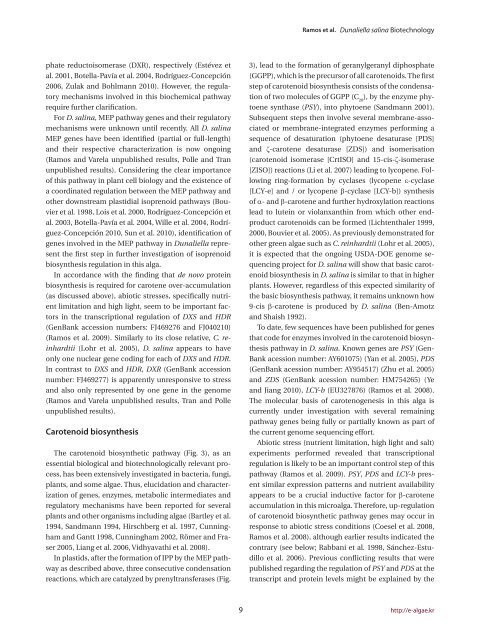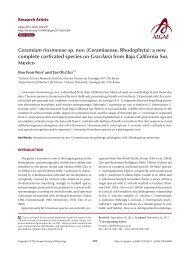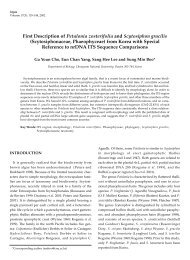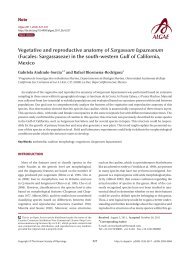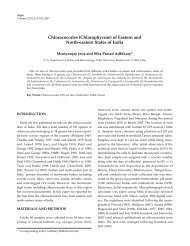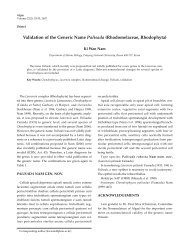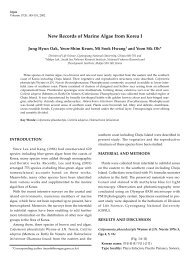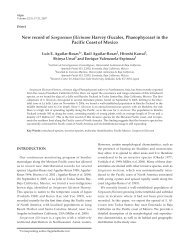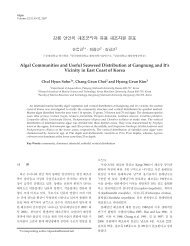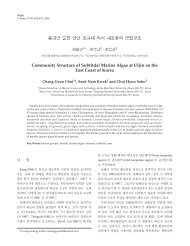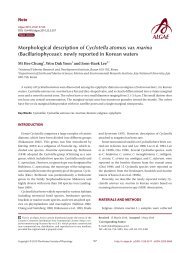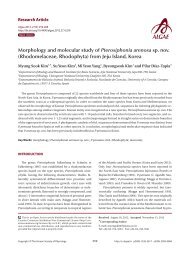The unicellular green alga Dunaliella salina Teod. as a model - Algae
The unicellular green alga Dunaliella salina Teod. as a model - Algae
The unicellular green alga Dunaliella salina Teod. as a model - Algae
You also want an ePaper? Increase the reach of your titles
YUMPU automatically turns print PDFs into web optimized ePapers that Google loves.
phate reductoisomer<strong>as</strong>e (DXR), respectively (Estévez et<br />
al. 2001, Botella-Pavía et al. 2004, Rodríguez-Concepción<br />
2006, Zulak and Bohlmann 2010). However, the regulatory<br />
mechanisms involved in this biochemical pathway<br />
require further clarification.<br />
For D. <strong>salina</strong>, MEP pathway genes and their regulatory<br />
mechanisms were unknown until recently. All D. <strong>salina</strong><br />
MEP genes have been identified (partial or full-length)<br />
and their respective characterization is now ongoing<br />
(Ramos and Varela unpublished results, Polle and Tran<br />
unpublished results). Considering the clear importance<br />
of this pathway in plant cell biology and the existence of<br />
a coordinated regulation between the MEP pathway and<br />
other downstream pl<strong>as</strong>tidial isoprenoid pathways (Bouvier<br />
et al. 1998, Lois et al. 2000, Rodríguez-Concepción et<br />
al. 2003, Botella-Pavía et al. 2004, Wille et al. 2004, Rodríguez-Concepción<br />
2010, Sun et al. 2010), identification of<br />
genes involved in the MEP pathway in <strong>Dunaliella</strong> represent<br />
the first step in further investigation of isoprenoid<br />
biosynthesis regulation in this <strong>alga</strong>.<br />
In accordance with the finding that de novo protein<br />
biosynthesis is required for carotene over-accumulation<br />
(<strong>as</strong> discussed above), abiotic stresses, specifically nutrient<br />
limitation and high light, seem to be important factors<br />
in the transcriptional regulation of DXS and HDR<br />
(GenBank accession numbers: FJ469276 and FJ040210)<br />
(Ramos et al. 2009). Similarly to its close relative, C. reinhardtii<br />
(Lohr et al. 2005), D. <strong>salina</strong> appears to have<br />
only one nuclear gene coding for each of DXS and HDR.<br />
In contr<strong>as</strong>t to DXS and HDR, DXR (GenBank accession<br />
number: FJ469277) is apparently unresponsive to stress<br />
and also only represented by one gene in the genome<br />
(Ramos and Varela unpublished results, Tran and Polle<br />
unpublished results).<br />
Carotenoid biosynthesis<br />
<strong>The</strong> carotenoid biosynthetic pathway (Fig. 3), <strong>as</strong> an<br />
essential biological and biotechnologically relevant process,<br />
h<strong>as</strong> been extensively investigated in bacteria, fungi,<br />
plants, and some <strong>alga</strong>e. Thus, elucidation and characterization<br />
of genes, enzymes, metabolic intermediates and<br />
regulatory mechanisms have been reported for several<br />
plants and other organisms including <strong>alga</strong>e (Bartley et al.<br />
1994, Sandmann 1994, Hirschberg et al. 1997, Cunningham<br />
and Gantt 1998, Cunningham 2002, Römer and Fr<strong>as</strong>er<br />
2005, Liang et al. 2006, Vidhyavathi et al. 2008).<br />
In pl<strong>as</strong>tids, after the formation of IPP by the MEP pathway<br />
<strong>as</strong> described above, three consecutive condensation<br />
reactions, which are catalyzed by prenyltransfer<strong>as</strong>es (Fig.<br />
Ramos et al. <strong>Dunaliella</strong> <strong>salina</strong> Biotechnology<br />
3), lead to the formation of geranylgeranyl diphosphate<br />
(GGPP), which is the precursor of all carotenoids. <strong>The</strong> first<br />
step of carotenoid biosynthesis consists of the condensation<br />
of two molecules of GGPP (C 20 ), by the enzyme phytoene<br />
synth<strong>as</strong>e (PSY), into phytoene (Sandmann 2001).<br />
Subsequent steps then involve several membrane-<strong>as</strong>sociated<br />
or membrane-integrated enzymes performing a<br />
sequence of desaturation (phytoene desatur<strong>as</strong>e [PDS]<br />
and ζ-carotene desatur<strong>as</strong>e [ZDS]) and isomerisation<br />
(carotenoid isomer<strong>as</strong>e [CrtISO] and 15-cis-ζ-isomer<strong>as</strong>e<br />
[ZISO]) reactions (Li et al. 2007) leading to lycopene. Following<br />
ring-formation by cycl<strong>as</strong>es (lycopene ε-cycl<strong>as</strong>e<br />
[LCY-e] and / or lycopene β-cycl<strong>as</strong>e [LCY-b]) synthesis<br />
of α- and β-carotene and further hydroxylation reactions<br />
lead to lutein or violanxanthin from which other endproduct<br />
carotenoids can be formed (Lichtenthaler 1999,<br />
2000, Bouvier et al. 2005). As previously demonstrated for<br />
other <strong>green</strong> <strong>alga</strong>e such <strong>as</strong> C. reinhardtii (Lohr et al. 2005),<br />
it is expected that the ongoing USDA-DOE genome sequencing<br />
project for D. <strong>salina</strong> will show that b<strong>as</strong>ic carotenoid<br />
biosynthesis in D. <strong>salina</strong> is similar to that in higher<br />
plants. However, regardless of this expected similarity of<br />
the b<strong>as</strong>ic biosynthesis pathway, it remains unknown how<br />
9-cis β-carotene is produced by D. <strong>salina</strong> (Ben-Amotz<br />
and Shaish 1992).<br />
To date, few sequences have been published for genes<br />
that code for enzymes involved in the carotenoid biosynthesis<br />
pathway in D. <strong>salina</strong>. Known genes are PSY (Gen-<br />
Bank acession number: AY601075) (Yan et al. 2005), PDS<br />
(GenBank acession number: AY954517) (Zhu et al. 2005)<br />
and ZDS (GenBank acession number: HM754265) (Ye<br />
and Jiang 2010), LCY-b (EU327876) (Ramos et al. 2008).<br />
<strong>The</strong> molecular b<strong>as</strong>is of carotenogenesis in this <strong>alga</strong> is<br />
currently under investigation with several remaining<br />
pathway genes being fully or partially known <strong>as</strong> part of<br />
the current genome sequencing effort.<br />
Abiotic stress (nutrient limitation, high light and salt)<br />
experiments performed revealed that transcriptional<br />
regulation is likely to be an important control step of this<br />
pathway (Ramos et al. 2009). PSY, PDS and LCY-b present<br />
similar expression patterns and nutrient availability<br />
appears to be a crucial inductive factor for β-carotene<br />
accumulation in this micro<strong>alga</strong>. <strong>The</strong>refore, up-regulation<br />
of carotenoid biosynthetic pathway genes may occur in<br />
response to abiotic stress conditions (Coesel et al. 2008,<br />
Ramos et al. 2008), although earlier results indicated the<br />
contrary (see below; Rabbani et al. 1998, Sánchez-Estudillo<br />
et al. 2006). Previous conflicting results that were<br />
published regarding the regulation of PSY and PDS at the<br />
transcript and protein levels might be explained by the<br />
9 http://e-<strong>alga</strong>e.kr


